B2B marketing frameworks help SMBs attract, nurture and convert prospects. With a clear model, teams can align strategy and resources for the best results.
While choosing and consistently applying a framework can be challenging, the right guidance helps teams stay focused and streamline their efforts to attract more qualified leads.
This article breaks down the most effective B2B marketing frameworks, shares real-world examples and shows you how to apply them in your business to drive predictable growth.
Key takeaways from B2B marketing framework
B2B marketing frameworks provide structure for executing and optimizing campaigns across the buyer journey.
Using the right framework helps SMBs attract qualified B2B buyers, build trust and manage complex sales cycles more effectively.
Many SMBs struggle to choose and consistently apply a framework, but aligning it with B2B sales goals and buyer needs solves this challenge.
Pipedrive’s CRM makes it simple to implement any framework with customizable pipelines that drive consistent revenue growth – start a free 14-day trial.
What is a B2B marketing framework?
A B2B marketing framework is a model that helps companies plan, execute and optimize marketing efforts for business audiences.
While specific B2B frameworks vary, most typically include the following elements:
Market research and audience analysis. Identifies target accounts, buyer personas and competitors to focus marketing on the most promising prospects.
Value proposition and messaging. Crafts clear, persona-specific messaging that highlights ROI and solves business problems.
Lead generation and nurturing. Creates content and marketing campaigns that educate, engage and guide B2B leads through the buying journey over time.
Lead management and sales alignment. Ensures smooth handoff between marketing and sales, using lead scoring, CRM tracking and collaboration to improve conversions.
Measurement and optimization. Tracks metrics (like sales KPIs) and benchmarks before analyzing results to refine campaigns and maximize ROI.
Technology and tools. Leverages customer relationship management (CRM), marketing automation and other analytics to scale and streamline marketing efforts.
These elements help SMBs focus resources effectively, align marketing with sales and create a clear path for turning B2B prospects into loyal customers.
How do B2B marketing frameworks differ from B2C frameworks?
B2B frameworks prioritize rational decision-making, longer multi-stage sales cycles and engagement of multiple stakeholders within a business structure.
B2C marketing frameworks focus on reaching individual consumers. They often emphasize quick conversions, emotional appeal and broad audience engagement.
B2B marketing also relies heavily on trust, relationship-building and demonstrating long-term value for businesses rather than driving instant purchases.
5 common B2B marketing frameworks
Choosing the right B2B marketing framework helps you focus your efforts, manage resources efficiently and generate high-quality leads that drive revenue.
Here are the five most common frameworks to help you determine what fits your business goals and audience best.
1. Account-based marketing (ABM)
ABM helps SMBs focus on high-value accounts with personalized campaigns, boosting conversions and ROI more effectively.
ABM software targets specific high-value accounts and tailors campaigns to each key stakeholder within those organizations. This approach ensures you allocate marketing resources to prospects most likely to convert.
Real-world example: E-signature software DocuSign has dedicated landing pages for its ideal industries.

The company then uses display ads to reach contacts at organizations in these departments and industries with personalized content.
Here’s an example of a LinkedIn ad from DocuSign aimed at procurement departments:

When to use ABM: ABM supports businesses with few high-value clients or complex sales cycles.
By targeting a limited set of strategic prospects, businesses can deliver highly personalized messaging, address multiple stakeholders’ needs and build a deeper client rapport.
These actions make it easier to navigate longer, multi-step B2B buying processes and close larger, more valuable deals.
2. Awareness, interest, desire, action (AIDA)
The AIDA model helps SMBs guide prospects through the entire buyer journey using targeted messaging and content marketing at each stage.
AIDA works by breaking the customer journey into four stages:

This structured approach ensures prospects receive information at the right time, increasing the likelihood of moving them toward a purchase.
Real-world example: A B2B manufacturer used AIDA to grow its reach and sales. Working with marketing agency Aidas Inc., the company transformed its marketing strategy to attract, engage and convert research labs and dealers worldwide.
Awareness (captures attention through educational content, social media marketing or advertising): The manufacturer had almost no digital presence, so the team built visibility through SEO-optimized content highlighting how the equipment serves research labs.
Interest (engages prospects with more detailed information about solutions and benefits): The company addressed the audience’s pain points (cost, reliability and lab efficiency) with problem-solution content.
Desire (highlights unique value propositions, case studies or testimonials to continue nurturing leads): By showcasing real use cases (“equipment in action”) and emphasizing benefits like efficiency and impact, the manufacturer created desire among prospects who wanted labs that perform better or save on cost.
Action (drives conversions with clear calls to action, offers or demos): The business increased sales by generating inquiries, expanding its dealer network and lowering the cost per lead.
As a result of these activities, the manufacturer doubled its dealer network, more than tripled inquiries and reduced cost per lead (CPL) by 35%.
When to use AIDA: AIDA is ideal for B2B businesses with longer, more complex sales cycles requiring a structured content and campaign approach.
By breaking down the buyer journey into clear, manageable stages, businesses can deliver timely messaging that generates conversions over a longer decision-making process.
Download our customer journey map template
3. Top, middle, bottom of the funnel (TOFU-MOFU-BOFU)
The TOFU-MOFU-BOFU framework helps SMBs deliver the right content at each buyer journey stage to attract, engage and convert leads efficiently.
The marketing framework works by dividing the lead funnel into three stages:

By mapping content to each stage, businesses can move prospects steadily toward purchase while avoiding generic messaging.
Real-world example: Castleberry Media helped a mid-sized office furniture brand increase sales by 29%. With a data-driven content marketing strategy, the company shifted its image from traditional supplier to innovative industry leader.
Here’s a breakdown of TOFU-MOFU-BOFU and how the furniture company used them:
TOFU (awareness). Marketing focuses on attracting new prospects. This content includes educational emails, blog articles or social posts that raise brand awareness.
Educational, evergreen content like “How to design the ideal office?” and “The psychological impact of remote work” drove organic traffic, growing visits by 250% and engagement by 150%.MOFU (consideration). Engages prospects who have shown interest. The content provides them with detailed information about your business, like case studies, webinars and guides to help evaluate solutions.
Industry-specific resources and AI-optimized content nurtured prospects, building authority and guiding architects and project managers toward solutions relevant to their projects.
BOFU (decision). Efforts focus on converting leads. Companies use sales demos, free trials, consultations and tailored offers to try and close deals.
Decision-stage content such as “Eight keys to choose the best supplier” helped prospects compare options and convert. The approach resulted in $1.5M+ in quarterly applications and 8% EBITDA growth.
Castleberry Media’s strategy turned educational content into a clear, repeatable funnel that efficiently attracts, nurtures and converts qualified leads.
When to use TOFU-MOFU-BOFU: Companies with complex buying processes involving multiple stakeholders and longer decision-making cycles will benefit most from this framework.
By segmenting content and campaigns, marketers maintain customer engagement at every stage of the buying journey. As a result, they educate prospects effectively and increase the likelihood of conversion.
4. Flywheel model
The Flywheel model places buyer satisfaction at the core of its strategy, turning existing customers into repeat business.
The framework uses a cyclical approach where each stage feeds into the next, creating continuous business growth.
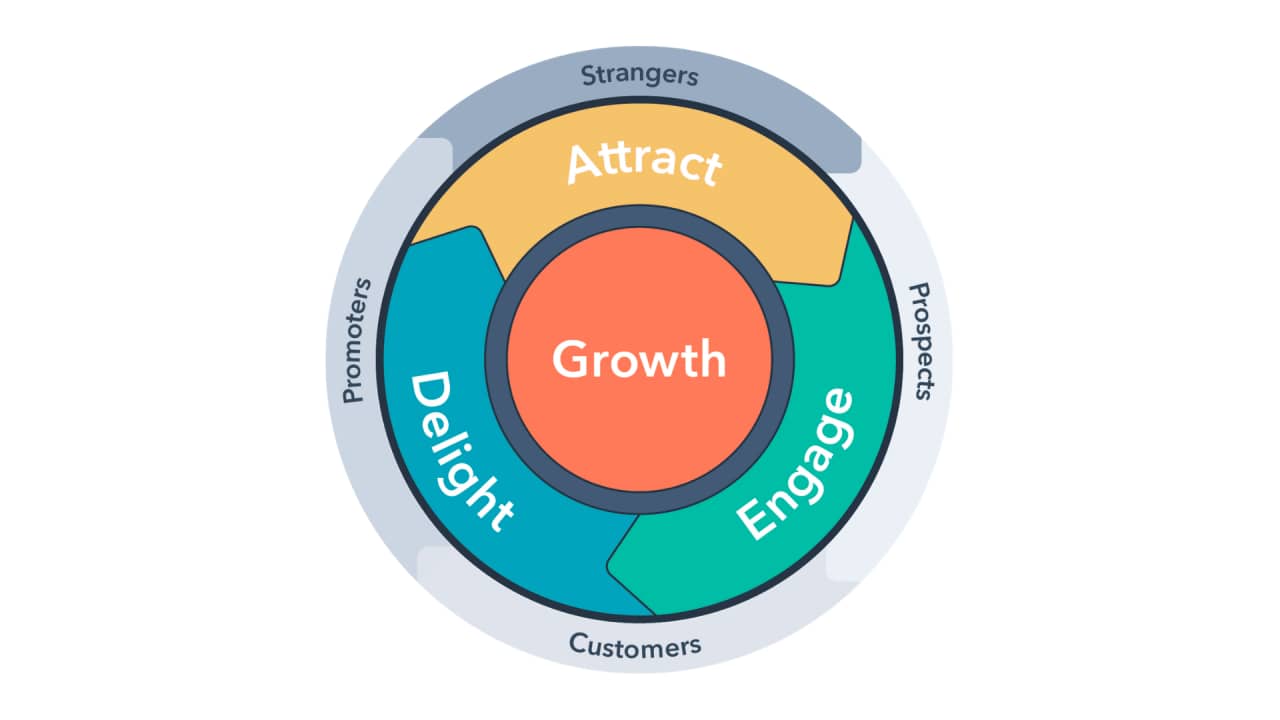
Here’s what each stage means:
Attract – businesses draw in potential customers through valuable content and experiences
Engage – focuses on building relationships by providing insights and solutions tailored to customer needs
Delight – ensures customers feel satisfied and supported, encouraging them to become promoters who refer others
The outer circle of the Flywheel shows the progression of how people interact with your business as the Flywheel spins.
The cycle starts with people who don’t know your business. After these people engage with your business (click, sign up or inquire), they become prospects. Here, sales and marketing work together to nurture interest.
When a prospect makes a purchase or signs a contract, they enter the customer stage. The focus now is on delivering value and excellent service.
If you do your job well, customers become promoters.
Promoters are delighted customers who advocate for your business. They write reviews, share referrals and post about your business on social media. These customers help attract new people into the Flywheel, restarting the cycle.
Real-world example: A promoter shares positive feedback about Delighted, an online survey platform.

By posting this information online, the promoter encourages new potential customers to enter the Flywheel and learn more about the business.
When to use the Flywheel: This model benefits B2B companies that aim to build long-term relationships, enhance customer loyalty and leverage word-of-mouth referrals to drive growth.
5. Reach, act, convert, engage (RACE)
The RACE framework helps SMBs plan, measure and optimize their marketing by breaking the customer journey into four clear stages.
Note: Smart Insights created the original RACE framework with four stages: Reach, Act, Convert, Engage. The organization added Plan as a preparatory step to help businesses set marketing goals, analyze the market and align strategies before executing campaigns.
Here’s how the model looks:

RACE emphasizes continuous optimization across every stage of the funnel, aligning marketing activities with business goals.
This optimization means SMBs quickly adapt to data and double down on what drives results, saving time and budget on marketing tactics that don’t perform.
Real-world example: Customer data platform Tealium uses the RACE framework and incorporates artificial intelligence (AI) into the process.
AI is transforming how B2B companies apply the RACE framework, especially for attracting and engaging prospects.
AI-driven agents now handle top-of-funnel interactions more intelligently than traditional chatbots. Instead of generic scripts, these agents are trained on sector-specific data, enabling them to share relevant insights, stats and case studies.
This functionality makes them powerful for education and lead nurturing at scale.
Here’s what each RACE stage represents and how Tealium uses AI throughout the framework:
Reach. Following a solid marketing plan, businesses build awareness by driving traffic through marketing channels like social media and paid advertising. The goal is to get in front of new prospects.
Tealium uses AI-powered insights to optimize SEO, capturing prospects searching online. These optimizations ensure the company appears in front of the right decision-makers at the right time.
Act. Encourages interaction, whether it’s downloading a whitepaper, signing up for a webinar or engaging with content. These actions move prospects closer to becoming qualified leads.
Tealium deploys intelligent AI agents on its site to engage visitors and recommend resources based on sector, role or pain point. These tailored responses improve the customer experience and move prospects through the sales funnel.
Convert. Prospects become customers through actions like booking a demo, signing a contract or making a purchase. This step is where sales and marketing alignment is critical.
When a lead shows intent, the AI agent hands them to a human sales rep. This smooth transition ensures qualified leads move faster into the sales funnel.
Engage. Focuses on customer retention and advocacy, using strategies like personalized email follow-ups, customer success programs and loyalty campaigns to turn customers into repeat buyers.
Tealium integrates AI-driven personalization into its customer success programs, using data to recommend additional resources and best practices. This information helps customers see more value and expand their usage over time.
Here’s an example of one of Tealium’s AI chatbots:
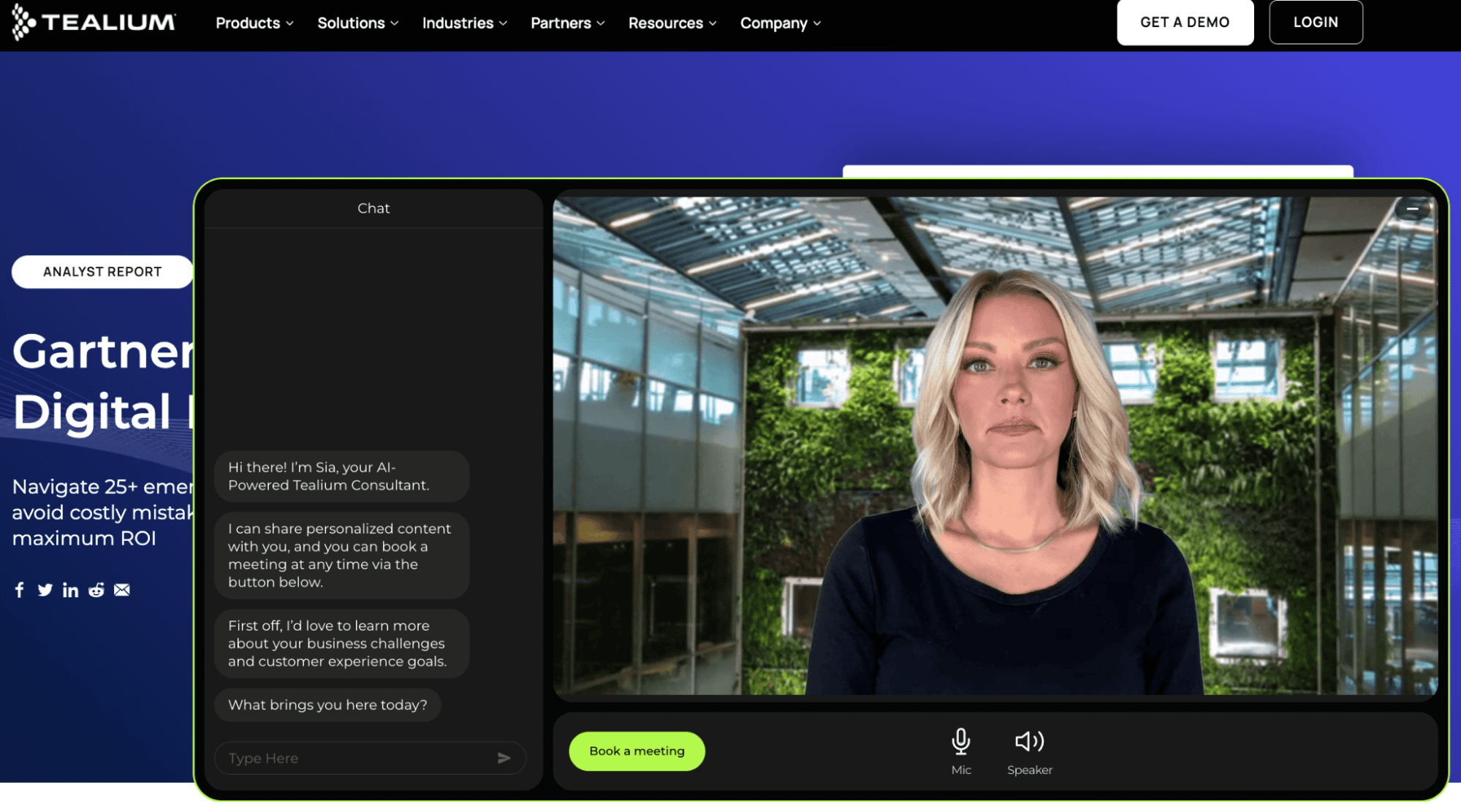
When to use the RACE model: RACE suits SMBs seeking a performance-driven approach to B2B marketing.
The framework provides structure across the customer journey, from planning through retention. By breaking activities into measurable stages, SMBs identify what works, allocate resources more effectively and optimize campaigns to drive growth.
Why is a B2B marketing framework essential for SMB success?
Effective B2B marketing attracts the right customers, builds credibility, supports complex sales cycles and drives higher conversions without overusing resources.
Take a look at these benefits in more detail:
Attract the right customers | B2B marketing helps your SMB identify and reach businesses most likely to need your products or services. By targeting the right customer profile, SMBs avoid wasting limited resources on unqualified leads and focus on prospects with the highest potential value. |
Build customer trust and credibility | In B2B markets, purchase decisions are often high-value and involve multiple stakeholders. Consistent, professional marketing (through content creation, case studies and thought leadership) establishes your SMB as a trustworthy partner, increasing the likelihood of winning deals – crucial for a small business’s continued success. |
Support longer sales cycles | B2B purchases usually involve research, evaluation and approval from several decision-makers. Effective marketing nurtures leads through every stage, keeping your brand top-of-mind until the prospect is ready to buy. As a result, your SMB increases its chances of selection over a larger and established competitor. |
Align marketing with sales for better conversions | Effective B2B marketing creates a seamless connection between marketing and sales teams. This alignment ensures timely lead qualification, nurturing and handoff. The process delivers a better customer experience and helps small teams focus on the most promising opportunities. |
An effective B2B marketing strategy helps SMBs grow sustainably. The process turns the right prospects into loyal customers while maximizing the impact of every marketing and sales effort.
How to choose the right B2B marketing strategy framework
The best marketing framework depends on your sales cycle, goals, resources and how your buyers make decisions.
Here are three key factors to consider when deciding which framework to apply to your B2B operation.
1. Match the framework to your sales cycle
Pick a framework that fits the length and complexity of your B2B sales process.
How to do it: Create a roadmap of your typical sales journey (from first touch to closed deal). Select a framework that provides the right structure to guide prospects through it.
Example: SMBs with smaller marketing teams and simpler deals may use AIDA, while those selling higher-value solutions benefit from ABM or TOFU-MOFU-BOFU.
2. Align with your goals and resources
The chosen framework should fit your business objectives and team capacity.
How to do it: Identify your priority (acquiring new leads, driving efficiency, building loyalty or improving conversions). Match this priority to the framework that best supports those outcomes.
Example: For SMBs aiming to grow through repeat business, the Flywheel methodology works well as it emphasizes customer satisfaction.
Businesses that focus on driving measurable B2B pipeline growth may benefit from the RACE framework, which uses data at every stage to optimize campaigns.
3. Focus on your ideal customer and content needs
Select a framework that reflects how your buyers research, evaluate and make purchasing decisions.
How to do it: Consider the information decision-makers need at each stage. Ensure your chosen B2B marketing framework supports creating and delivering that content effectively.
Example: SMBs with limited digital marketing resources can benefit from frameworks like RACE to structure campaigns efficiently and generate measurable results.
Pipedrive makes it easier for SMBs to visualize and manage their sales cycle, no matter which B2B marketing framework they adopt. The following section explains how.
How Pipedrive helps SMBs with B2B marketing
Pipedrive’s sales CRM helps SMBs identify and prioritize target accounts with segmentation, lead scoring and automation.
Start by segmenting prospects by industry, company size and engagement history to pinpoint your most important leads. Then, use lead scoring features to rank their readiness.
Here’s how to score leads in Pipedrive:
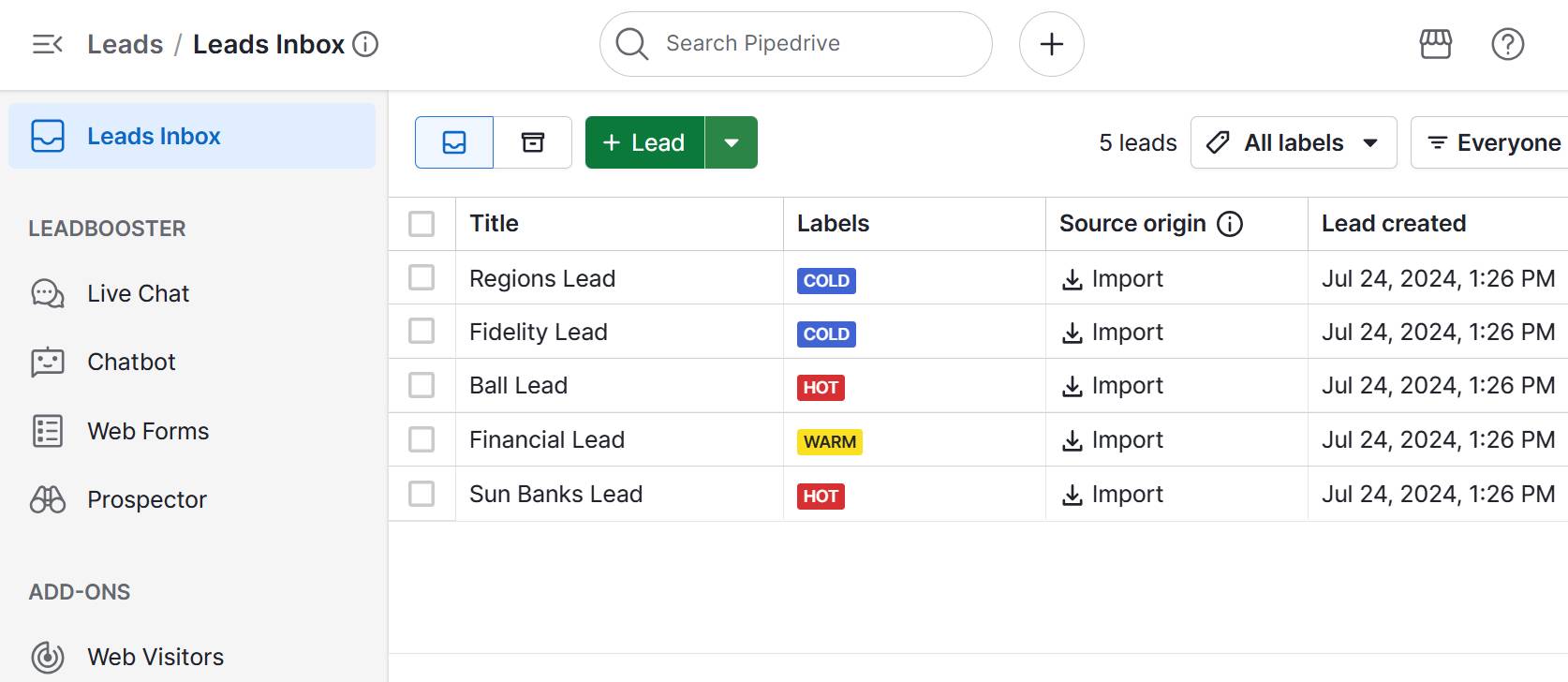
From here, you can nurture leads effectively by automating email marketing campaigns. Below is an example of an email automation sequence in Pipedrive:
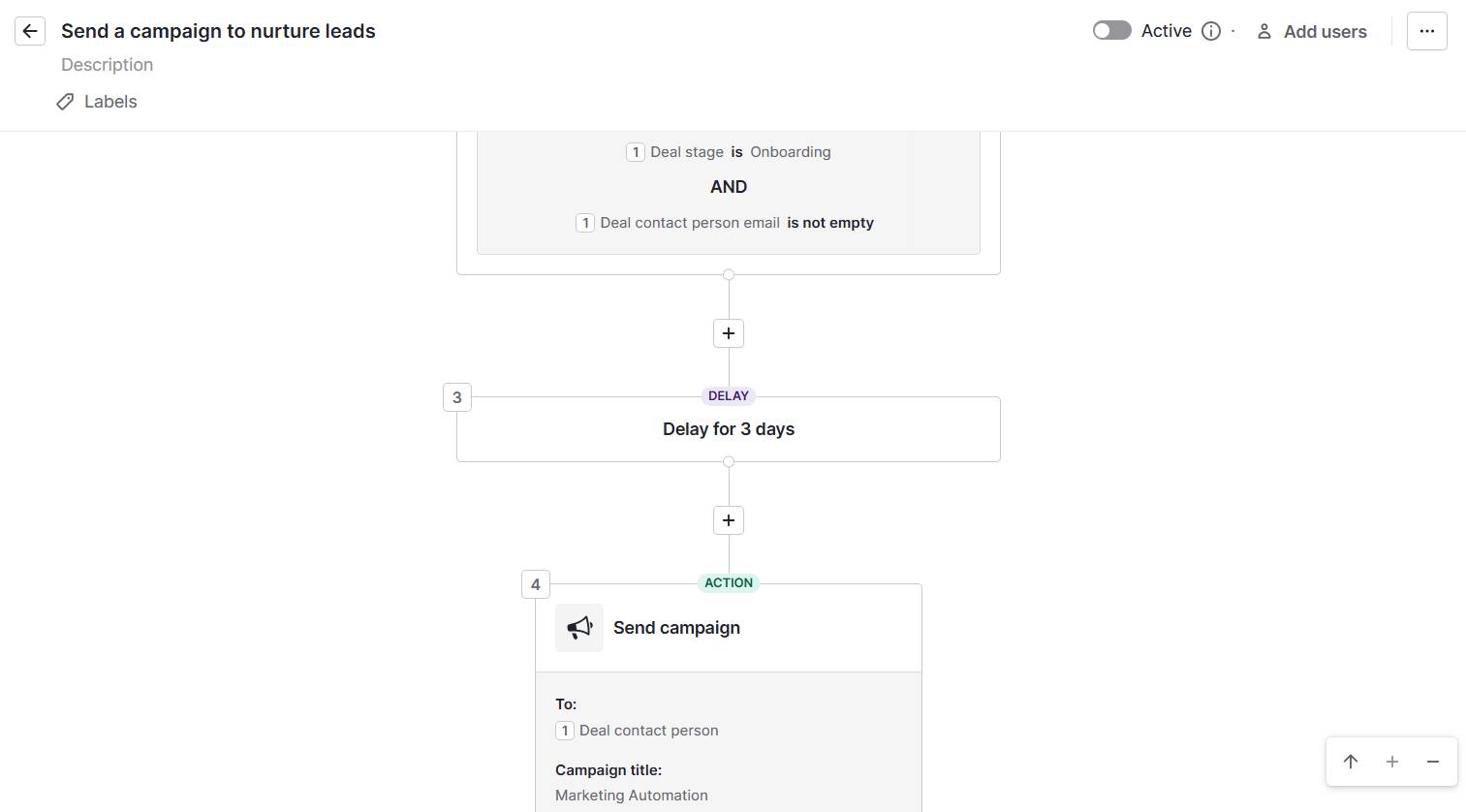
Tailor these campaigns to the specific needs, pain points and decision-making roles of each stakeholder within your target accounts. These communications help you build stronger relationships and improve the likelihood of getting new clients.
Pipedrive in action: MediaVision grew lead conversion rates by using Pipedrive add-ons (like LeadBooster) to track, capture and assign leads efficiently. As a result of the CRM doubling automation efforts, the performance marketing agency increased lead creation by 30%.
ABM also allows SMBs to focus on high-value accounts with personalized, data-driven strategies. Using Pipedrive’s CRM system, businesses can efficiently prioritize, nurture and convert their most important B2B prospects.
For example, create custom stages that reflect TOFU, MOFU and BOFU in your SMB’s sales pipeline. Options include:
Triggering automated email sequences for TOFU prospects to educate them
Following up with MOFU leads using case studies and relevant content
Delivering BOFU communications that include personalized offers or demo invitations
This flexibility makes it easy to track leads as prospects progress, assign deal priority and automate targeted communications for each stage.
Pipedrive in action: Soundproofing tech company Framery used Pipedrive to understand website visitors’ behaviors and intentions. With these insights, it identified high-intent leads and engaged them with personalized content at each funnel stage, increasing lead generation by 800%.
Here are some examples of the types of email templates you can create in Pipedrive to nurture leads through the TOFU, MOFU and BOFU funnel:
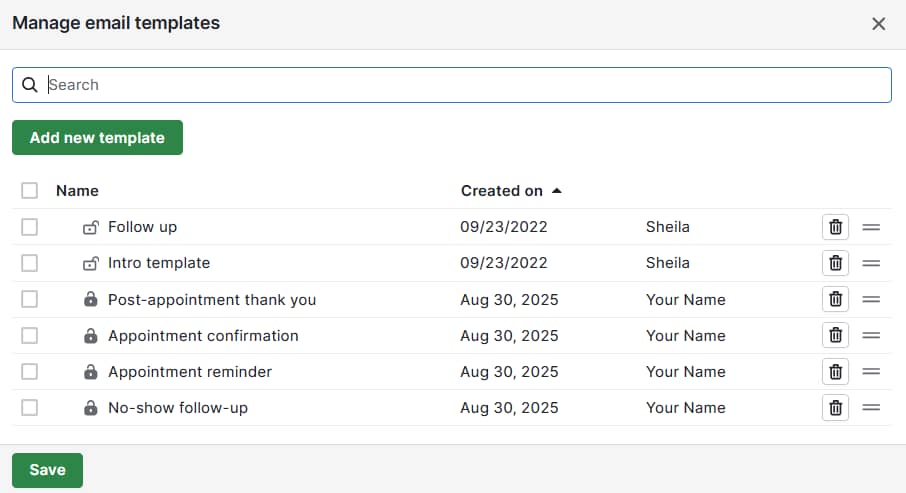
By leveraging TOFU-MOFU-BOFU in Pipedrive, your SMB can nurture leads efficiently and convert high-quality prospects.
Final thoughts
B2B marketing frameworks give SMBs structure to attract, nurture and convert the right prospects. Choose the right model by aligning it with your sales cycle, goals and how your buyers make decisions.
Pipedrive makes it easy to implement these frameworks with customizable pipelines that mirror each stage, helping teams stay aligned and move deals forward.
Start your free 14-day trial to turn your chosen marketing framework into consistent B2B revenue growth.







